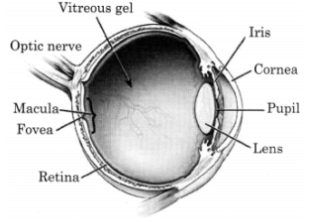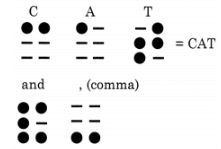Class 7 Science Chapter 13 Question Answers - Light
Q1: Differentiate between rod and cone cells.
Ans: Rods are the rod-shaped cells present in the retina of an eye which are sensitive to dim light whereas cones are the cone-shaped cells present in the retina of the eye which are sensitive to bright light.
Q2: What is the far point and near point of the human eye with normal vision?
Ans: In optics, the farthest and closest point at which an object can be brought into focus by the eye are called far point and near point of the eye respectively. The far point of the human eye with normal vision is infinity. The near point of the human eye with normal vision is 25 cm.
Q3: What is a mirror?
Ans: A piece of glass with a shiny metal-covered at back, that reflects light, producing an image of the object in front of it is known as a mirror.
Q4: What is aqueous humour?
Ans: The space between the cornea and lens is filled with a liquid called the aqueous humour.
Q5: What is lateral inversion?
Ans: The phenomenon of changing the left side to the right and the right side to the left by the mirror while forming an image is called lateral inversion.
Q6: What is irregular reflection?
Ans: Irregular reflection is defined as the reflection of light from an uneven surface. In irregular reflection, the reflected beam is not parallel.
Q7: State the two laws of reflection.
Ans: The two laws of reflection are:
- The angle of incidence is always equal to the angle of reflection.
- The incident ray, the reflected ray, and the normal all lie in the same plane.
Q8: List the characteristics of an image formed in a plane mirror.
Ans: The characteristics of an image formed in a plane mirror are:
- It is virtual.
- It is erect.
- It is of the same size as the object.
Q9: How do we see various objects?
Ans: We see various objects due to reflection. As we know all surfaces reflect light, when light falls on any object, it reflects the light. The reflected light reaches our eyes and we are able to see the object.
Q10: What is reflection?
Ans: The bouncing back of light into the same medium after it falls on a surface is called reflection.
Q11: What do you mean by the reflected ray?
Ans: The ray of light which is returned back into the same medium after the incident ray strikes the surface is called the reflected ray.
Q12: Define light.
Ans: Light is defined as a form of energy that stimulates sight and makes things visible.
Q13: Explain the phenomenon of dispersion of light.
Ans: Dispersion is defined as the phenomenon of splitting of white light into different colours on passing through a transparent medium such as prism. When white light is passed through a prism, it splits into seven colours. It is observed that the colours are in the following order:
- Violet (V), Indigo (I), Blue (B), Green (G), Yellow (Y), Orange (O) and Red (R).
- The order of colours can be remembered by the acronym VIBGYOR. This coloured band is called spectrum of white light.
Q14: Write the ways to protect your eyes.
Ans: Eyes are very delicate organ that enable us to see this colourful world. Thus, we must protect our eyes and take proper care of them.
Following are the ways to protect the eye:
- Always sit straight while reading or writing.
- Never read while walking or lying down.
- Wash your eyes frequently with clean water.
- Never read in the dim or too much bright light.
- Never rub your eyes with hands.
- Never bring the book too close to your eyes.
- Eat foods rich in vitamin A.
Q15: Write a note on ‘The Human Eye’.
Ans: Eye ia a sense organ that enables us to see the world around us. It is roughly spherical in shape. Human Eye
Human Eye
- The first part that is bulged outward is called ‘cornea. It protects the eye.
- Behind the cornea, the coloured part of the eye, iris is present. It controls the size of the pupil.
- Pupil is a small opening in the cornea which allows the light to enter the eye.
- Behind the iris, eye lens is present which is a convex lens. It focus the image on retina, by bending the light rays.
- Retina is the inner back surface of the eye which acts as a screen to form image. It is sensitive to light.
- The sensation of the image formed on the retina is carried to the brain by the optic nerve.
Q16: Explain some common eye defects in human.
Ans: Some eye diseases are:
- Cataract: A cataract is a clouding of the lens in the eye leading to a decrease in vision. It can affect one or both eyes. Often it develops slowly. Symptoms may include faded colours, blurry vision, halos around light, trouble with bright lights, and trouble seeing at night. This may result in trouble driving, reading, or recognising faces. Cataracts are the cause of half of blindness and 33% of visual impairment worldwide. Cataract is treated by replacing the opaque lens with a new artificial lens.
- Myopia: Near-sightedness or myopia, is the most common refractive error of the eye. Myopia occurs when the eyeball is too long, relative to the focusing power of the cornea and lens of the eye. This causes light rays to focus at a point in front of the retina, rather than directly on its surface. It can be corrected using spectacles made of concave lens.
- Hypermetropia: Hypermetropia or long-sightedness occurs when eyeball is too short or the cornea or crystalline lens does not refract the light enough. This lead to formation of the image of a nearby object behind the retina. A hypermetropic person may have blurred vision when looking at objects close to them, and clearer vision when looking at objects in the distance. By placing a convex (plus powered) lens in front of a hypermetropic eye, the image is moved forward and focuses correctly on the retina.
- Astigmatism: It is a defect in the eye or in a lens caused by a deviation from spherical curvature, which results in distorted images, as light rays are prevented from meeting at a common focus. It can be corrected by using a convex lens or concave lens or both.
Q17: Write a short note on Braille system.
Ans:
- The most popular resource for visually challenged persons is Braille. Braille system was developed by Louis Braille. He himself was a visually challenged person. There is Braille code for common languages, mathematics and scientific notation. Many Indian languages can be read using the Braille system.
- Braille system has 63 dot patterns or characters. Each character represents a letter, a combination of letters, a common word or a grammatical sign. Dots are arranged in cells of two vertical rows of three dots each. Patterns of dots to represent some English letters and some common words are shown in Fig.

- These patterns when embossed on Braille sheets help visually challenged persons to recognise words by touching. To make them easier to touch, the dots are raised slightly.
- Visually challenged people learn the Braille system by beginning with letters, then special characters and letter combinations. Methods depend upon recognition by touching. Each character has to be memorised. Braille texts can be produced by hand or by machine. Typewriter-like devices and printing machines have now been developed.
|
666 docs
|















